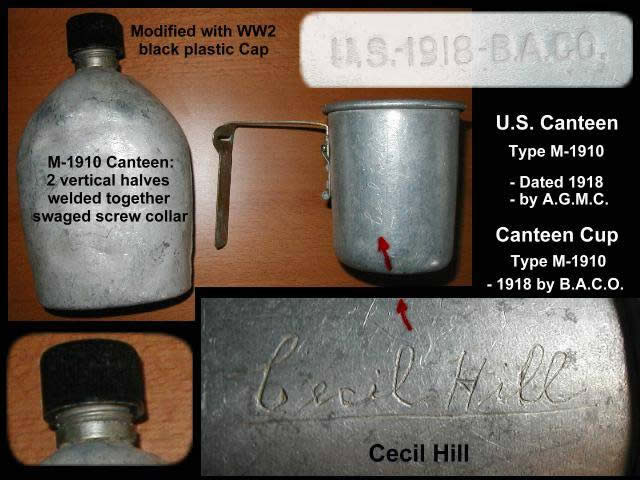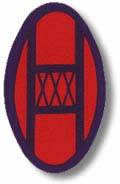Recently I bought myself a nice M1910 Canteen set; a M1910 Canteen (vertically welded canteen by AGMCo 1918) and a M1910 Canteen Cup (by BACO -1918-). The canteen set was found inside a M1941 Canteen Cover, dated 1941 by stamp.

Why did I buy this WWI type of canteen, and not the
horizontal welded, more common 1942/1943 Type Canteen ? The first Paratroops
were issued 'early' War gear. 1941/1942 issued goods consisted richly out
of World War I stock, being stored away for all those years.
Later the U.S. Army started cranking up the production pace to supply the huge
mobilized Army with new gear. One of the old Army sayings of that era was pretty
cynical; 'Remember that your weapon was made by the company with the lowest
bid!'.
So the flat 'English' type of helmet (brain bucket) was replaced by the M1 helmet, the M1910 canteen by the new (and much quicker made) type of canteen. (There also was a rare enamel version). More new gear: gasmasks, new(er) patches (some combined), uniforms and jackets (like M1942 taker jacket or the Ike jacket -often created by 'field modification'-), even new boots in late 1944 (buckleboots...).
This particular canteen has a WW2 cap of black plastic material (modification). The original cap for the M1910 canteen is smaller. Together with the distinctive screw collar swaged to the neck and the fact that the WW1 era canteen was welded together vertically (in stead of horizontally like the WW2 canteens) this 'early' canteen can be identified pretty easy.
But my M1910 set had a surprise engraved on the side: Cecil Hill.
Could this Canteen Cup have belonged to Cecil E.
Hill, service number 37515709, Sergeant in the 119th Infantry Regiment of
the 30th Infantry Division (The Old Hickory)?
He entered the Service from Missouri and died on the 24th of September 1944.
Cecil is buried at Plot A Row 13 Grave 45 of the Henri-Chapelle American Cemetery
in Belgium.
He was awarded the Purple Heart Medal. I am planning to visit his grave within
the next months.

On the 30th Infantry Division:
The 30th Infantry Division landed on Omaha Beach France on the 10th June
1944. It fought it's way up to the St Lo area, and beyond during Operation
Cobra.
The Division relieved the 1st Infantry Division near Mortain in August 1944
and was seriously tested during the battle for Avranches. The Americans liberated
the key-location of Avranches on July 31st 1944, opening the way into Brittany.
Late August 1944 the 30th Infantry Division pushed East in the trackmarks
of the 2nd Armored Division, crossing into Belgium in the direction of Luik.
On the 14th of September 1944 the 117th and 119th Infantry Regiments advanced
into Maastricht. The 119th and 120th Infantry Division attacked the 'West
Wall' to the north of Aken, near Geilenkirchen, to continue across the Wurm
River early October.
A map is on display here.
In that last period (the end of September 1944) Cecil E. Hill lost his life.
I have been in contact with Mr. Frank Towers, the
Executive Secretary Treasurer and Historian for the 30th Infantry Division
Association. He wrote me: 'that the combat files for
the 30th Infantry Division have been lost in a disastrous fire at St. Louis,
MO in 1973.'
He advised me to contact a special agency that may have more information on
Cecil, so I wrote them a letter.
On the date that Cecil Hill died Frank Towers came
up with this information:
'The history of the 119th regiment doesn't give any details
of the action of that date. However, his unit was in the vicinity of Heerlerbaan,
Schaesburg and Nieuwenhagen, while they were patrolling in the Siegfried Line
area.'
Questions:
Special thanks to Mr. Frank Towers. I was privileged to meet him in Normandy, on D-Day 2002. His blue jacket and cap, with the Old Hickory Logo, made him easy recognizable.